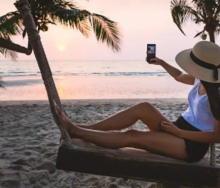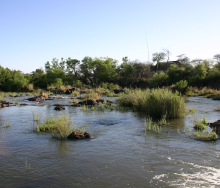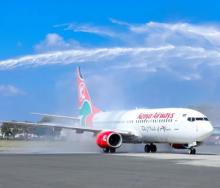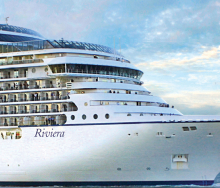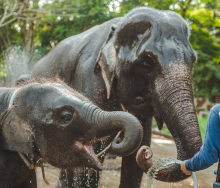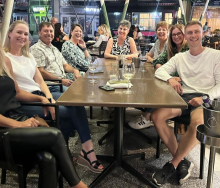An Indian Ocean island with a difference
NOSY Be is an island just
off the northwest coast
of Madagscar, and is
surrounded by other, smaller
islands that can be explored on
day trips or longer charters. It’s
worth pointing out that Nosy Be
is not a resort-style destination
in the mould of, for example,
Mauritius.
“We think Nosy Be is a
fantastic attraction in the
general archipelago, and the
beaches and the islands that
you find when exploring off
Nosy Be itself,” says Rosie
Palframan, owner of tour
operator, Barefoot Breaks. “A
lot of the surrounding islands
have lodges with a rustic
feel. And they’re small, from
six rooms to around, at the
biggest that we sell, 25 rooms.
It’s a lot more personal than
the typical resort experience.”
Authentic and unspoilt
Rosie says a lot of modern
tourism makes use of a
fairly homogenous type of
product, which has become
commercialised to the point
that, in some cases, a lot of
the original reason why people
went to a destination in the
first place has been diluted or
disappeared.
“For the South African
market, Mauritius is a good
example of this. Every beach
is pretty much wall-to-wall
resorts, and a lot of them are
very similar in character,” she
says. “There are a growing
number of people who actually
reject that, and are increasingly
alienated by it. They’re looking
for something more authentic,
more off the beaten track, and
more personal. And Nosy Be
is a perfect example of exactly
that,” she says.
“At just about any beach on
Nosy Be, guests can snorkel
straight off the beach,” says
Rosie. “That’s quite unique.”
She says, in essence, this is
the point of travelling to Nosy
Be. Travellers will be going to
places that have not yet been
commercialised, and while
they do have tourist facilities,
to a large extent they remain
unspoilt. “The coral reefs are
still in excellent condition.
But more than the sea life,
there is also the tropical, lush
vegetation on land. Zanzibar,
for example, is a lot more arid,
but Nosy Be has rainforests,
with unique wildlife like
lemurs.”
Finding the right fit
“Nosy Be is most certainly a
family destination, but I feel it
is wasted on the very young,”
says Harriet Joao, owner of
MadagasCaT.
“A sense of adventure and a
sense of humour are essential
when travelling to Madagascar,
but not all the lodges are really
equipped for the very young.
“Any age from about six
upwards will enjoy the holiday.”
Harriet points out that Nosy
Be has a 10-month season,
starting in March and ending in
December. “That said, the very
best time to visit is between
the beginning of May and the
end of November. It becomes
very hot and humid with heavy
night-time rainfall at other
times of the year.”
A scuba paradise
CHRIS Hoare, chief revenue
officer at Airlink, says Nosy Be
and its surrounding islands are
must-visit locations for South
Africans interested in scuba
diving. “It’s close, at three and
half hours from OR Tambo,
compared with the long-haul
flights needed to get to diving
destinations such as the Red
Sea, for example. And it’s a
direct flight. Previously, the
only way to get there was via
Antananarivo. But we go direct
to Nosy Be.”
Nosy Be has a 250 nautical
mile reef system (463km),
which, Chris says, has the
added advantage of keeping
the fishing trawlers out of
the area, maintaining the
pristine fish life and corals.
As it’s on the western side of
Madagascar, it is sheltered
from the prevailing northeasterly
winds and tropical
cyclones that arrive from
late January to March on the
eastern side of Madagascar,
says Chris.
“When you dive in South
Africa, usually you’re dealing
with commercial entities that
are trying to maximise what
they do with their equipment,”
says Chris. “They limit the
amount of time you can spend
underwater, 50 minutes, 50
bar. But in Nosy Be they don’t
pressure you during the dive,
so you can really relax and
maximise your underwater
time.”
Chris says that given the
calm seas and the variety
of dive sites, an open-water
dive certification will be fine,
because the planning of the
dive can be geared to the
experience level of the diver.
“Deeper dives and night dives
will require more advanced
certification,” Chris points
out. “Generally, for logistical
reasons, Nitrox is not that
readily available, but the
profiles and the planning of
the dives is such that you can
still do up to three dives a day
without compromising safety.
Talking of safety, there is a
DAN-accredited decompression
chamber facility on Nosy
Be, which is pretty unique
in the context of other dive
destinations in our region.”
Game lodges on the beach
“There is no real star-rating
system in Madagascar,”
says Rosie, “But what you
have are luxury lodges and
simple lodges.”
She says the top luxury
lodge in Nosy Be is the
Constance Tsarabanjina.
“I would compare it more
to a game lodge, but on
the beach. It’s more like
the ‘one island, one resort’
lodges that you find in the
Seychelles, such as Denis
Island, as opposed to a
more traditional Cape Town
or Mauritius hotel/resort.”
Rosie says, while the
accommodation is luxurious,
it lacks the facilities
required to score highly
on a traditional star-rating
system, such as TVs,
in-room telephones, or room
service.
Instead, the emphasis
is on having great
accommodation in the midst
of the stunning location.
And when it comes to
the simple lodges, the
game lodge on the beach
analogy remains apt.
“Perfect examples would be
Antoremba, Ankazoberavina
and Sakatia,” says Rosie.
Another form of
accommodation is the
live-aboard charters.
MadagasCaT Charters &
Travel has two live-aboard
catamarans, both of which
can sleep eight people.
“Yacht Gecko is ideal for
small groups of family,
friends or honeymooners,
while MY Maki CaT caters
for slightly bigger groups
and is the only proper liveaboard
boat for fishing and
diving charters in the area,”
says Harriet. “It’s important
to note the itinerary is not
set in stone and depends
on tides, weather and
clients’ ability.”
Getting there
Airlink currently operates a
direct Sunday flight
from Johannesburg to
Nosy Be. The flight departs
Johannesburg at 09h30,
and arrives in Nosy Be at
14h00, with the return flight
departing Nosy Be at 14h45,
and arriving in Johannesburg
at 18h45. Airlink also offers
an additional seasonal flight.
The current periods for the
Wednesday flight are until
October 10, and then from
December 19 until January
2, 2019.
Sustainable diving
Jacques Vieira, a diving
instructor, says Sakatia
Island is special because
of its green turtle
population. “A small team
of us have fought for over
four years to get this turtle
area protected. This year
we succeeded and now
we have an area marked
with buoys and no more
motorised vessels are
allowed to come into this
zone.
“Our dive guides are
well trained and are all
passionate about diving.
“The lodge has started
a project called ‘Reef in a
Bottle’, where we recycle
wine bottles and use
cement blocks to set them
in, to make artificial reefs
and to regrow coral.
“Another element is
whale sharks, which
come into the area to
feed on the plankton
during October, November,
and December,” says
Chris. “There’s a marine
conservation project
based on Nosy Be that is
conducting studies into
the behaviour of these
visiting whale sharks.
There are also humpbacks,
dolphins and the recently
discovered Omura’s
whale.”
More than just diving
NOSY Be offers excellent
catch-and-release game
fishing, says Rosie
Palframan of Barefoot
Breaks, with marlin and
barracuda being plentiful.
An alternative fishing option
also allows travellers to
experience the local way of
life. “Many of the lodges can
arrange for guests to go out
with a local fisherman for the
day on their wooden dugout
canoes where you typically
fish with a hand line.
Other activities include
quad biking, horse riding,
visits to Lemuria Land (a
small park with lemurs and
snakes) and the ylang ylang
perfume and rum distilleries.
“The various lodges usually
offer a range of waterbased
activities, including
snorkelling, kayaking and
stand-up paddle boards,”
says Rosie. “There are
also excursions on offer to
islands like Nosy Antsoha,
Nosy Tanikely – fantastic
snorkelling, including
with turtles – and Nosy
Iranja, arguably the most
beautiful spot in the entire
archipelago, and to local
villages.”
Lighting up the ocean
An amazing experience for divers is the fluorescent
night diving, or ‘fluo’ diving. Divers use black lights to
illuminate the corals and the marine life during the
dive, and the sea life fluoresces. Because the waters
are relatively calm, you can almost be assured that if
you plan to go on a night dive on a Tuesday, then you
will do a night dive on a Tuesday!
Did you know?
Cyclone season occurs from around the end of January to the middle
of March. A lot of the lodges close during this time.
